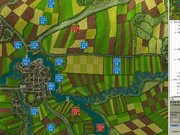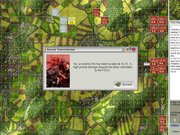Though it thankfully hasn't come to pass (yet), World War III is still a fascinating hypothetical setting for wargame fans. For nearly half a century, the United States and its Western allies braced for an onslaught by the Red Army and the Warsaw Pact nations on the plains of Germany. This titanic showdown is the focus of Flashpoint Germany, an entirely new wargame from Matrix Games and developer Simulations Canada. Flashpoint Germany is actually the spiritual heir to two of the earliest games on the subject: Main Battle Tank--Central Germany and Main Battle Tank--Northern Germany. However, since those games were released more than a dozen years ago, it's an understatement to say that computing power has changed since then. Flashpoint Germany updates the gameplay to modern-day standards, and the result is an excellent introductory wargame full of taut and exciting moments.

Set in 1989, the game postulates that the Soviet Union, seeing the writing on the wall, decides not to collapse peacefully but rather to gamble it all on a risky conventional attack into West Germany. The game picks up in northern and central Germany, where the British, American, and German army corps try to fend off the gigantic mass that is the Red Army. You can play on either side in the conflict, and you'll experience the highs and lows of a battalion commander on a very lethal battlefield. The game features a scale of 500 meters per square, and you'll command tank and cavalry platoons and companies over a 20-by-15-square-kilometer stretch of Germany.
In terms of complexity, Flashpoint Germany is a remarkably easy game to pick up and play. The game comes with a two-mission tutorial that will walk you through the basics, and within 20 to 30 minutes you'll be ready to take on the enemy. The beauty of the game is that it doesn't require you to micromanage and handhold each of your units all of the time. Instead, the game places you in the role of a battalion commander. Every turn, you can issue basic orders to your units. Once your moves are made, the game then calculates and displays how the next 30 minutes unfold, and you see the results. After that 30-minute "pulse" is completed, the next turn begins, and you start the cycle over again.
This system is excellent in a number of ways. First, it captures the experience of command quite well. Modern combat takes pace at such a hyper pace that it's impossible for any commander to micromanage his units. At one point, you have to simply trust that your subordinates can carry out your plan to the best of their abilities. Second, it can make for some incredibly tense moments. In one mission, a US armored cavalry regiment was tasked with securing a German town. Thinking that we were in a race with the Soviets, we sent a tank company racing down the highway only to have them run smack into a Soviet motorized infantry regiment. That was a nasty shock, and we spent the rest of that turn watching desperately as the battle unfolded. (The lesson in this is to use your reconnaissance assets, because that's what they're for.)
The game also models some of the difficulties and dangers involved in command. You can limit the number of orders you can issue per turn to reflect the fact that your staff can do only so much in so little time. Even worse is that if you chatter too much on the radio, the opposing side will triangulate on your position. Both sides reserve plenty of artillery for just such an occasion. If your headquarters unit is wiped out, a lower-level HQ unit will take over, though at the cost of even longer delays between orders being issued to the frontline troops and the troops carrying out the orders. That delay represents the lag in any complex organization, especially one that's coping with the incredible stresses of combat.
In terms of tactics, Flashpoint Germany does an excellent job of capturing the challenges of winning on a modern battlefield. Because high-tech weapons are so lethal and accurate, the general rule in warfare is that if you can see it, you can kill it. That puts a premium on keeping your units hidden and scattered until the crucial moment. Of course, that's great if you're on the defense, but if you're tasked with attacking, you will eventually have to expose your units in the open. In that case, it's all about using your reconnaissance assets to determine where the enemy is and where he is not, and then maneuvering appropriately. Regardless of which side you play, you'll quickly envy the other side for its advantages. NATO forces are highly trained and lavishly equipped with high-tech weapons, but the Warsaw Pact nations, though possessing less-elite troops and equipment, have the luxury of numbers. In either case, you'll also discover that modern warfare is all about constantly maneuvering. Even if you find a great defensible position, if you stay there too long the enemy will just unload artillery and air strikes on you.

To keep things simple, the designers have made some notable omissions in the game. Some players will be disappointed to learn that the game abstracts infantry, and independent infantry units don't appear in the game at all. This isn't a major issue, because in this kind of warfare, infantry are nothing more than speed bumps to the tank columns. A bigger omission is combat engineers, which are useful for preparing the battlefield and obstacles. The game abstracts them as well, as each unit has an innate amount of combat engineering support to it. This can lead to sometimes peculiar results, such as when each individual tank platoon in a company can deploy its own bridge to cross a river. If only real-life platoons had such resources.
The artificial intelligence in the game is an adequate opponent at best. To its credit, it can actually display some imagination. For example, rather than charging you from a straightforward direction every time, the computer will attempt pincer and flank moves on your position. This will keep you on your toes; even a lower-quality Warsaw Pact unit at the right place and time can wreak havoc on NATO forces. That said, the computer also displays some dubious behavior. For instance, if you're playing as the Pact, you may be surprised to see the defending NATO forces coming at you and exposing themselves rather than lying in ambush. And still no computer can match the cleverness and guile of a human opponent. Thankfully, Flashpoint Germany supports both online and play-by-email multiplayer options. PBEM is especially simple; all you have to do is make your moves, and the game can directly e-mail the saved game to your opponent.
Graphically, Flashpoint Germany looks great for a wargame, though that's not saying a lot. There's absolutely no mistaking Flashpoint Germany for a real-time strategy game, as the graphics are composed primarily of traditional wargame unit counters on a map. On the other hand, the game comes with a modern and sleek interface, and the maps themselves are bright, colorful, and sharp. Even better, the game runs in a window on your desktop, allowing you to multitask with ease. On the downside, though, the game comes with only four maps and 17 scenarios. There is no mapmaking utility, but there is a game editor to make your own scenarios. The game also has a number of quirks, such as some very small text windows that can't be resized. It would also be nice to be able to print other windows, such as the map of the battlefield. Finally, the game keeps track of everything that occurs in a log, which is useful for analyzing after the battle, though it can be hard to read. It would be nice if it were color-coded or organized in a way to make it easier to analyze. Meanwhile, in terms of audio, the sound effects are entirely rudimentary and consist mainly of cannon fire and explosions.
Though there's obvious room for improvement, as a first-generation product Flashpoint Germany displays an exciting amount of promise and potential. It's relatively low learning curve and user-friendly game design make it especially accessible to beginning wargamers, and the scale of the game doesn't threaten to overwhelm you. And while it also sports some obvious flaws, that doesn't change the fact that this is an engaging and fun wargame that puts you in the middle of the greatest war that never was in history.